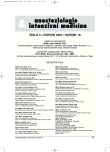-
Medical journals
- Career
The evolution of airway management
Authors: J. Pokorný
Authors‘ workplace: Komise pro historii oboru České společnosti anesteziologie, resuscitace a intenzivní medicíny ČLS JEP
Published in: Anest. intenziv. Med., 18, 2007, č. 3, s. 181-186
Category: History
Overview
This article describes the most important steps of the evolution of the contemporary methods of airway management in anaesthesiology and critical care. In the 19th century the principal method of safeguarding the open airway was tracheostomy, cannulation of the trachea and supralaryngeal tamponade prior to the beginning of general anaesthesia and surgery. Trendelenburg (1869) was the first one to use an inflatable cuff for sealing the tracheostomy cannula. MacEwen introduced inserting the tracheal tube into the larynx through the mouth in 1878. The method was improved by Maydl in Prague (1893). Magill and Rowbotham developed a well usable method of endotracheal intubation and nasotracheal blind intubation in the 1920s. Guedel developed convenient types of nasal and oral airways in the same years. He and Waters reintroduced the cuffed rubber endotracheal tube. Macintosh contributed to the technique of endotracheal intubation by introducing the curved laryngoscope blade in 1943. Thanks to the introduction of the intravenous anaesthetic thiopentone by Lundy and Waters in 1934, and muscle relaxants by Griffith in 1942, it was possible in the 1950s to develop a method for the induction of general anaesthesia with endotracheal intubation still used today.
Key words:
laryngoscopy – tracheal intubation – thiopentone – muscle relaxants
Labels
Anaesthesiology, Resuscitation and Inten Intensive Care Medicine
Article was published inAnaesthesiology and Intensive Care Medicine

2007 Issue 3-
All articles in this issue
- Altering the hemodynamics during abdominal aortic aneurysm repair by acute normovolemic hemodilution
- Early resuscitation of septic shock to different levels of arterial blood pressure
- Impact of addition of synbiotics (Synbiotic 2000 Forte) to enteral nutrition on the course of MODS, occurrence of sepsis, immune status and gut function in long-term critically ill patients
- Extended immunologic profile taken during the first days in the ICU and the prognosis of patients requiring long-term intensive care
- Monocyte activation during the first days in the ICU and survival in a heterogeneous group of patients requiring long-term intensive care
- Helium and its role in current medicine
- The evolution of airway management
- Anaesthesiology and Intensive Care Medicine
- Journal archive
- Current issue
- Online only
- About the journal
Most read in this issue- Helium and its role in current medicine
- The evolution of airway management
- Altering the hemodynamics during abdominal aortic aneurysm repair by acute normovolemic hemodilution
- Impact of addition of synbiotics (Synbiotic 2000 Forte) to enteral nutrition on the course of MODS, occurrence of sepsis, immune status and gut function in long-term critically ill patients
Login#ADS_BOTTOM_SCRIPTS#Forgotten passwordEnter the email address that you registered with. We will send you instructions on how to set a new password.
- Career

